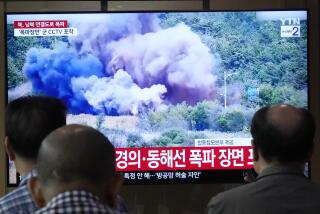Anger smolders a year after S. Korean monument destroyed
SEOUL — This city’s 600-year-old Sungnyemun gate survived the Japanese occupation and the Korean War, but it could not endure the anger of a 69-year-old man and his simmering grudge against the South Korean government.
A year ago, Chae Jong-ki arrived at the nation’s most revered monument, armed with an aluminum ladder, three bottles of paint thinner and two cigarette lighters.
Enraged that the government had ignored his complaint about a land disagreement, the onetime fortuneteller started a blaze that destroyed the 14th century wood-and-stone pagoda-shaped structure.
On Tuesday’s anniversary of the fire, Lim Young-suk, 68, tightly clutched her husband’s arm as she attended a daylong exhibition at the site of the landmark, which is undergoing a four-year, $20-million reconstruction. The aim of the display was to raise awareness of the nation’s cultural heritage. But it only made Lim grieve her nation’s loss all over again.
“I still feel like crying when I think about it,” she said. “This gate is the post that holds South Koreans together.”
Situated in the center of what is now a major downtown traffic circle, surrounded by skyscrapers, the ancient gate had stood in marked contrast to Seoul’s breathless modernization.
“If the Arc de Triomphe fell down, it would shock most Parisians,” said Lee Kang-geun, an architectural history professor at Kyongju University in Kyongju. “For Koreans, this is as significant as the Arc de Triomphe.”
In sentencing Chae to 10 years in prison, a judge ruled that the arsonist “inflicted unbearable agony on the people and damaged national pride.”
Many also blame officials for the loss, complaining that lax security allowed Chae easy access, and the criticism has extended to protection for other national landmarks.
The government has embarked on an ambitious and controversial project to rebuild the gate. A move to collect private funds was publicly ridiculed by many who said that because officials had allowed the tragedy to happen, they should pay for the work themselves.
“It’s a tough job to satisfy people who experienced such a huge national loss,” said Jang Ku-yeon, an official with the Sungnyemun restoration project team at the Cultural Heritage Administration. “They were really frustrated.”
But preservationists are battling more than just public anger as they struggle to re-create the landmark, which was constructed with long-forgotten craftsmanship.
The two-story Sungnyemun gate, also known as Namdaemun, was completed in 1398 during Korea’s Chosun Dynasty, the southern gate in the original walls surrounding the capital city. It was designated a national treasure in 1962.
Officials have conducted a nationwide search for 100-year-old pine timber similar to that used on Sungnyemun. The wood must first be dried for two years to avoid cracking.
They also are trying to re-create the original Chinese text of a wooden tablet that hung on the gate. About 3,000 pieces of wood have been salvaged from the wreckage, which officials hope to put back together.
Experts say the challenges aren’t just technical.
“It’s hard to capture the feelings and soul of the ancestors who built this,” said Choi Ki-young, a nationally recognized historical preservationist. “You can’t know what was on their mind unless they are here to guide us.”
After the fire, authorities sealed off the charred ruins with a mammoth plastic screen that depicts the pre-fire landmark. On the night of the fire, Chae climbed up the western wall and used his ladder to enter the wooden tower, pouring paint thinner on the floor.
Chae had been convicted in 2006 of setting fire to another South Korean landmark, nearby Changgyeong Palace, an attack that caused $4,200 in damage.
Firefighting efforts to save the gate were hampered by fear that excessive water and equipment would damage what was left of the structure. Firefighters thought they had snuffed the blaze without serious damage, but around midnight it reignited and destroyed the landmark.
Chae later told police that he chose Sungnyemun because of the lax security -- motion detectors that were easy to evade. He is said to have expressed remorse. “No words are enough to express my apology to my children and the people,” he reportedly told investigators.
Waiting in line in a steady rain Tuesday morning, Kang Sun-ja, one of the estimated 5,000 visitors who would tour the ruins by day’s end, said she had come to see what remained of the place she considers a vital part of her national heritage. And she wasn’t in the mood to bestow any forgiveness on the man who burned it down.
“Even if he was executed,” the 63-year-old homemaker said of Chae, “I’d still be angry at him.”
--
Ju-min Park of The Times’ Seoul Bureau contributed to this report.
More to Read
Sign up for Essential California
The most important California stories and recommendations in your inbox every morning.
You may occasionally receive promotional content from the Los Angeles Times.











